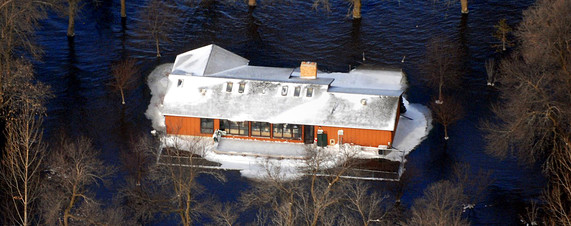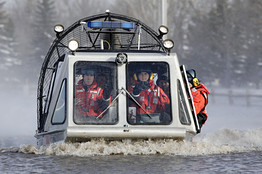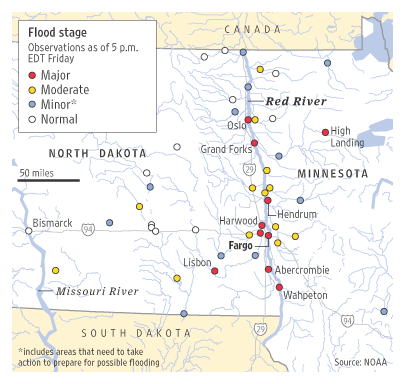
Fargo, North Dakota - Residents here teetered between hope and fear after the Red River rose to record levels on Friday and threatened to overflow the city's dikes.
But the mayor of Fargo said Saturday he is "optimistic" about a new forecast saying the river may already have crested and could drop in the coming days.
The weather service had said earlier that the Red River could crest as high as 43 feet. But forecasters put out an alert Saturday saying the river is expected to remain below 41 feet and slowly decrease in the coming days.
Fargo Mayor Dennis Walaker said the city needs to continue to be diligent. But he said he is optimistic weary residents may have seen the worst after a long week of flood prevention.
A winter storm is expected to hit the region in the coming days, and Mr. Walaker acknowledged that the weather could change the flood outlook for the Red River. On Saturday, the National Weather Service said conditions seem to be improving and may not be as dire as originally expected.
Despite the forecast revision, North Dakota officials still intensified their efforts to fend off the floodwaters, deploying high-tech Predator drone aircraft, calling up more National Guard troops and asking residents to be on the lookout for any breaches in levees.
After a night piling sandbags atop the levee a block from his house, Bo Slater gave way to his anxiety Friday. He backed up a rental truck to the front porch and began loading his furniture, TV and computer.

"I don't think it's going to flood real bad, but just in case this is our precaution," he said. The 23-year-old truck driver lives with his girlfriend and her three children in their yellow two-story house. With his valuables loaded up and ready to go, Mr. Slater said he would stick by his home until an emergency evacuation or the sand bags failed.
As Mr. Slater and his friends filled the truck, city officials announced the river had swelled to 40.32 feet -- just inches above the previous high water mark of 40.1 feet, recorded in 1897. The National Weather Service on Friday forecast the river would crest Saturday at 43 feet, equal to the height of the dike protecting the city. City officials said they believed the Red River would crest at about 42 feet.
"None of us, no matter how old, have ever seen the river this high," said Mr. Walaker, the mayor. Cracks in the levees had prompted hundreds of people to evacuate from endangered neighborhoods in this city of more than 90,000 residents.
Up the street from Mr. Slater, the owners of the Lashkowitz High Rise, a 22-story apartment complex, asked more than 200 residents to evacuate. "The dike is weakest at the top," said office manager Kathryn Steffens, while crews worked to shore up the protective wall. "We don't know if it's going to crack."
City officials asked residents to minimize their driving to keep roads clear for emergency vehicles and trucks hauling sand bags. Paula Grimestad, executive director of the Red River zoo, reported calls from residents wondering whether they could dump their more exotic pets there.
Fargo, together with Moorhead across the river in Minnesota, is the metropolitan area most in danger along the Red River. Grand Forks, to the north, was devastated by floodwaters in 1997 and then constructed an elaborate flood-protection system; city officials have expressed confidence it will contain the Red River when it is expected to crest at about 53 feet in Grand Forks early next week.
Fargo, spared disaster in the major floods of 1997, is anxiously scrambling to hold back the rising waters now. Mr. Walaker, working on four hours' sleep Friday, said his main worry was the ability of the levees to withstand the water pressure should it persist at high levels for several days. Fargo expected to have 1,700 National Guard troops from across the state and the country patrolling the protection walls. The mayor said the city had three million sand bags and was holding 10% in reserve for emergency action.
City officials in a Friday afternoon news conference said it was time to "stand and defend" the dikes and called on residents to monitor the flood walls in their own neighborhoods and report any breeches. "If we're going down," the mayor said earlier in the day, "we'll go down swinging."
Over at the FargoDome, home of the North Dakota State University athletics, hundreds of volunteers Friday were swinging sand bags onto trucks to the rhythm of rock music. "I want to help the community," said Morgan Schuck, a 20-year-old junior at the university as "Life in a Northern Town" blared over the loudspeakers. "I don't want it to go under."
The Red River runs along the North Dakota-Minnesota border and flows northward to Canada. An usually cold and snowy winter produced a large snowpack sitting on top of frozen ground. A warm spell and heavy rain melted the snow and ice, which flowed into the river and quickly raised water to historic levels.
The return of cold winter weather has served both as friend and foe. Freezing temperatures kept a heavy blanket of snow and ice from melting and adding to floodwaters. But the temperatures also made sand bags too rigid to stack on top of the levee walls or easily fill into gaps. "Like tossing frozen turkeys," described Mr. Walaker.
Mr. Slater and his friends added a couple of feet of sand bags to the top of the levee by his house before preparing for a possible evacuation.
Up the street, Darren Hall had also spent the night sandbagging, raising his stretch of the levee to 44 feet. He said he was determined to overcome worries and stay in his house, which was built in the 1890s and has survived every flood since, including the last record-breaker in 1897. "I think we're going to be OK," he said. "I'm very optimistic as long as we don't have any more moisture from a storm."




Reader Comments
to our Newsletter